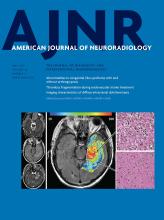Abstract
BACKGROUND AND PURPOSE: The entorhinal cortex, a critical gateway between the neocortex and hippocampus, is one of the earliest regions affected by Alzheimer disease–associated neurofibrillary tangle pathology. Although our prior work has automatically delineated an MR imaging–based measure of the entorhinal cortex, whether antemortem entorhinal cortex thickness is associated with postmortem tangle burden within the entorhinal cortex is still unknown. Our objective was to evaluate the relationship between antemortem MRI measures of entorhinal cortex thickness and postmortem neuropathological measures.
MATERIALS AND METHODS: We evaluated 50 participants from the Rush Memory and Aging Project with antemortem structural T1-weighted MR imaging and postmortem neuropathologic assessments. Here, we focused on thickness within the entorhinal cortex as anatomically defined by our previously developed MR imaging parcellation system (Desikan-Killiany Atlas in FreeSurfer). Using linear regression, we evaluated the association between entorhinal cortex thickness and tangles and amyloid-β load within the entorhinal cortex and medial temporal and neocortical regions.
RESULTS: We found a significant relationship between antemortem entorhinal cortex thickness and entorhinal cortex (P = .006) and medial temporal lobe tangles (P = .002); we found no relationship between entorhinal cortex thickness and entorhinal cortex (P = .09) and medial temporal lobe amyloid-β (P = .09). We also found a significant association between entorhinal cortex thickness and cortical tangles (P = .003) and amyloid-β (P = .01). We found no relationship between parahippocampal gyrus thickness and entorhinal cortex (P = .31) and medial temporal lobe tangles (P = .051).
CONCLUSIONS: Our findings indicate that entorhinal cortex–associated in vivo cortical thinning may represent a marker of postmortem medial temporal and neocortical Alzheimer disease pathology.
ABBREVIATIONS:
- AD
- Alzheimer disease
- EC
- entorhinal cortex
- SE
- standard error
- © 2017 by American Journal of Neuroradiology
Indicates open access to non-subscribers at www.ajnr.org












